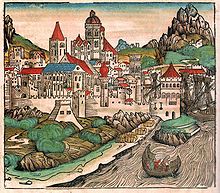Amnon of Mainz
Amnon von Mainz (also Amnon von Mentz) is the main character of what is probably the most famous medieval Jewish legend.
He is said to have lived in Magenza ( Mainz ) around 940–1040 (according to the Jewish calendar around 4700–4800) .
The legend
Amnon is an urbane and respected Mainzer Jew, whom the archbishop repeated attempts of Mainz, for Christianity to convert (other traditions for it is a Duke of Hesse.) To the bishop one day get rid of once again, Amnon asked three days to think it over, to go inside. No sooner had he said this than he regretted it, interpreting it as a doubt about his own belief.
As Amnon did not want to come on the appointed day for this reason, the archbishop had his guards pick him up and bring him to the bishopric. Amnon, inconsolable over what he had said, let the bishop know to cut off his tongue for his words. The bishop replied that he would not have his tongue cut off because she spoke well, but his feet because they did not come and his hands too, and so it was. The victim was then allowed to be carried home.
A little later is Rosh Hashanah , the Jewish New Year festival. Amnon allows himself to be brought into the synagogue with his severed limbs, which have now been salted in , and seated next to the prayer leader. When the latter wants to start the lecture, Amon interrupts him. He himself wants to sanctify the name of God and loudly recites the pijjut “ And now let us describe the mighty holiness of this day ... ”, that of the divine judgment day, which is connected with Rosh Hashanah. As soon as the pijjut is finished, he disappears from the eyes of those present, because his God has taken him to himself. However, three days later, Amnon appears to Rabbi Kalonymos ben Meshullam , teaches him this prayer and instructs him to spread it in his memory.
history
The oldest record of this story can be found in the writings of Israel von Krems around 1400 later in the Vilna Talmud , the oldest printed tradition is in the Machzor Roma from 1540. From there it was taken over by Gedalja ibn Jachja in his Schalschelet haqabbala , from where it was hers Gained popularity.
The Russian writer Simon Frug used it as a template for a novel, Maxim Sakaschansky made it into a German-language Jewish drama.
literature
- Lucia Raspe: Jewish hagiography in medieval Ashkenaz. Tübingen, Mohr-Siebeck, 2006, p. 130 f.
Web links
- Chabad.org: Rabbi Amnon of Mayence
- [1] by Gotthard Deutsch , Amnon of Mayence (Mentz) , in: Jewish Encyclopedia.
